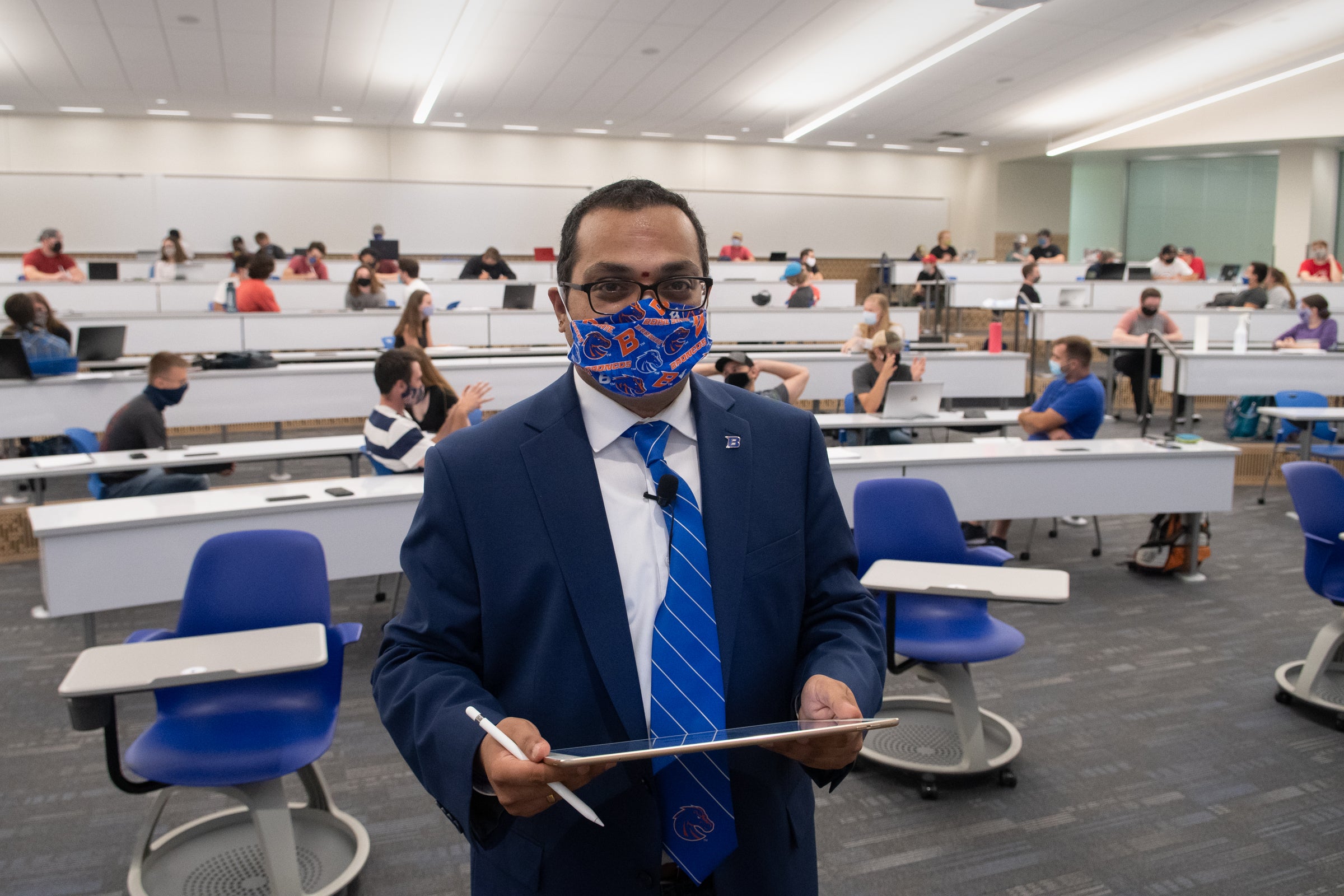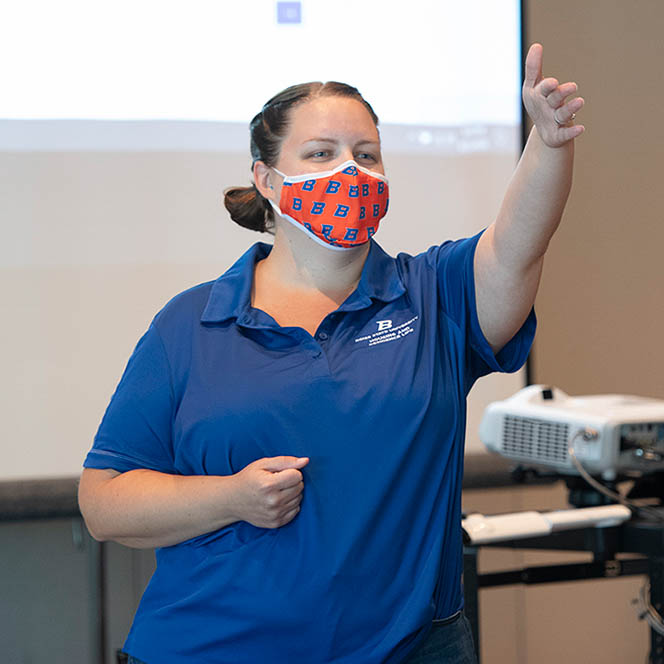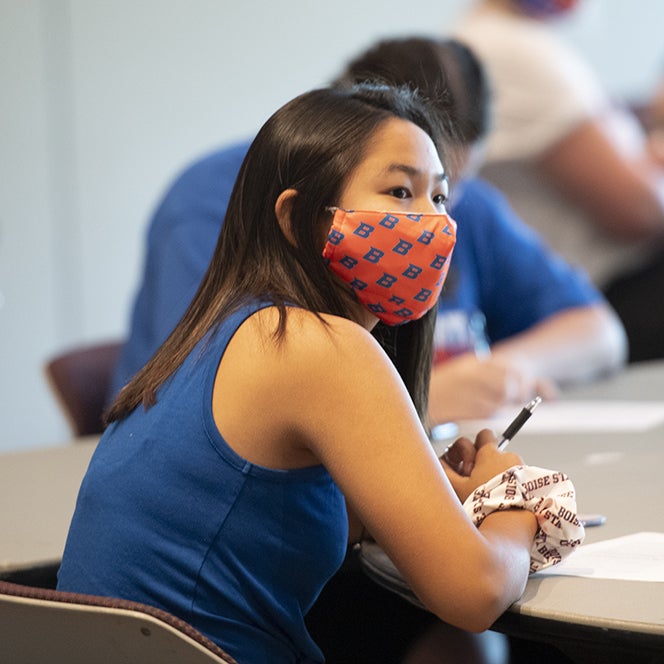
Imagine being an educator and walking into classrooms each day not knowing what to expect: an empty lecture hall, 90 students studiously spread at six-feet intervals, or some combination of the two.
Despite the uncertainties the pandemic has introduced, hundreds of Boise State faculty and staff labored through the fall 2020 semester to ensure students received just as vigorous and valuable an education through in-person or remote learning. While last year one-quarter of Boise State classes were available online, more than half of Boise State’s class offerings transitioned partially or fully to remote learning in fall 2020.
Alongside his fellow Boise State faculty, Krishna Pakala, an assistant professor of mechanical and biomedical engineering navigated the unforeseen challenges and limitations of the COVID-classroom to empower students to learn with flexibility, empathy and resilience.
Like many faculty at Boise State and across the globe, Pakala had to adjust his in-person courses this fall due to the COVID-19 pandemic. However thanks to innovative thinking, Zoom, screen-sharing and a wireless microphone, he ensured his students would learn the exact same material regardless of whether they were present in the classroom or learning remotely – and each week, they had the option of coming to class or simply logging on.
“While we think about what we should do in our new world, there are pieces in the old world that are still important – such as creating community, knowing students’ names and calling on them in the classroom or on Zoom,” Pakala said. “You make them feel that they’re part of the class and they’re valued not as a number but as a person.”
Pakala routinely solicited anonymous feedback from his students to ensure he and his students’ expectations were in alignment during these unusual times. So far, the feedback has been all positive.
“Talking about campus resources and other tangents, it’s refreshing to be able to hear the professor talk like another human and help us through school and other issues we have,” one student noted.
Fellow faculty member Caile Spear, a professor of community and environmental health taught health advocacy and foundations of health education and promotion in the fall semester. All her courses were in-person with new online supplements, like discussion questions, so that students who could not make it to class still got credit for their work.
Perhaps most importantly, Spear started the fall semester by soliciting buy-in from her students.
“One of the ways that I’ve worked to try to address the challenges is to be as flexible as possible, to try and make sure that there are going to be options for students,” said Spear. “We started to make classroom guidelines for what would make a comfortable learning environment. It seemed like it all boiled down to one word and that was ‘respect’ – that we would have respect for each other.”
For Spear, this was especially meaningful as her husband dealt with underlying health problems that made the possibility of contracting COVID all the more concerning.
“He didn’t ask me to not teach in person because he knows how much it means to me,” Spear said. “And [that first day of class] they were all wearing their facial coverings and I asked if I could take a picture… he responded right away and said ‘thank you’ to the students.”
Building community during a pandemic
The campus experience is much more than just the classrooms. Dorm life during COVID took on a very different meaning for residents, but fortunately dedicated faculty members like Pakala and Michal Temkin Martinez, an associate professor of English, continued to lead their Living and Learning Communities – unique residence halls that blend academics and daily life through classes, activities and live-in professors.
Their job was made safer thanks to a new public health team at Boise State, which proactively tested and traced all COVID cases on campus, as well as overseeing on-campus quarantine housing for those who need it.
Still, these educators faced greater challenges this year – among them, helping students feel supported, even at a distance. Physical distancing rules in the dorms limited the number of students using certain spaces at once – like lounges – and discouraged lingering in hallways, which is where Temkin Martinez used to welcome meaningful conversations with students.
“I’m used to having a lot of one-on-one interactions with my students,” said Temkin Martinez, who has lived in the residence halls for seven years. “I’m missing those intimate conversations that start informally but end up being about career advice, life advice, or just sharing parts of who I am in the hopes that it helps them understand their role in the world.”
Like Temkin Martinez, Pakala said that connecting with students on a personal level – in the dorms and in the classroom – is vital. On the first day of class, he shared his family’s personal battle with COVID-19.
“My dad was in the hospital with COVID for 40 days,” he said. “We thought three times in the last 40 days that we wouldn’t have my father back. Sharing some of those moments and saying to students, ‘we can do the learning but we must also appreciate the world right now. We will have a successful class if we manage expectations,’” was vital.

Using online learning platforms to engage students in new (and familiar) ways
“Innovating” doesn’t have to mean re-inventing the wheel – it could mean using that wheel in a different way, to support something vital. That’s what many faculty did in their classrooms, and online, each day: using familiar technology to build relationships with students in new ways.
For instance, when Doug Myers, an associate professor in community and environmental health, had to move his in-person epidemiology and analysis courses online, his biggest concern was ensuring that students could still connect with each other. As he pointed out, Zoom meetings don’t exactly encourage side conversations or foster the kind of study-buddy bonds new students need to be successful in college.
To tackle this problem, Myers worked to be available before class and during scheduled “breaks” so that students can talk informally with him – and each other. He also used humor in the classroom to keep students interested (and yes, he does see the humor in having an infectious disease class disrupted because of a global pandemic).
“I try to be entertaining while teaching in person, I find this makes students relax a bit and keeps them engaged,” he said. “I’m trying harder while doing this online. It’s definitely a challenge! It’s hard to be amusing when you don’t get audible feedback. I have to look around the screen to see who’s – hopefully – smiling or laughing.”
His colleague, associate professor Mike Mann, used a different approach to getting students, and the material, to click together: socially distanced group walks.
Temkin Martinez also employed this with her nine-person seminar in linguistics, too.
“I canceled class and we went on a walk instead,” she said. “It was so revitalizing. I think it was really important for me to have that connection with my students. We talked about class for only a few minutes. Mostly, we talked about how they’re doing. I declared it a mental health day and explained it was as much for me as for them.”

Finding hope during uncertain times
There’s no denying that students, faculty, staff, families – everyone is struggling to adjust to a new normal during the COVID pandemic. The unknowns of how long the pandemic will last, and what the post-COVID landscape will look like, takes a toll on everyone’s mental health. Still, faculty are proving themselves to be emotional and thoughtful leaders during these uncertain times.
They root out the hope in these unforeseen circumstances and share it.
“I’m inspired by colleagues doing amazing things, by students who persevere when course content gets tough, and by conversations with friends and family who are going through similar struggles,” said Kathrine Johnson, a clinical associate professor.
“My hope is that the way we treat students, the expectations that we set for them, make them more compassionate humans when they leave here and allow them to do the innovative and important work outside of academia that is centered on compassion and serving their community and our world,” said Temkin Martinez.
For Spear, watching her students be vulnerable and honest and face new challenges to their education head on was incredibly inspiring.
“I have students that have to go home and take care of their family, because nobody else
can. And they’re driving hours, or they’re having to go to Twin Falls. [But] we come
together. And we’re honest. And we say it’s hard, and that we support each other.”
-By Cienna Madrid